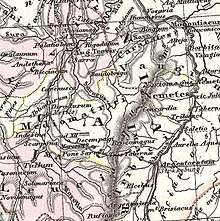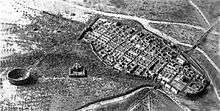Mediomatrici
The Mediomatrici (Greek: Μεδιομάτρικες)[1] were a Belgic tribe, dwelling in the present-day Lorraine region.[2]


Name
They are mentioned as Mediomatricorum and Mediomatricis by Caesar (mid-1st c. BC),[3] as Mediomatrikoì (Μεδιοματρικοὶ ) by Strabo (early 1st c. AD),[4] as Mediomatrici by Pliny (1st c. AD),[5] as Mediomatricos by Tacitus (early 2nd c. AD),[6] and as Mediomátrikes (Μεδιομάτρικες) by Ptolemy (2nd c. AD).[7][8]
The name Mediomatrici derives from the Gaulish *Medio-māteres (literally 'middle-mothers'), formed with medios ('in the middle, central') attached to matir ('mother').[9] It has been interpreted as the 'Mothers of the Middle-World' (i.e. between the sky and the underworld), or as 'between the Matrona (Marne) and the Matra rivers' (i.e. the mother-rivers).[9][10]
The city of Metz, attested as civitas Mediomatricorum around 400 AD ('civitas of the Mediomatrici'), is named after the Celtic tribe.[11][12]
Geography
The territory of the Mediomatrici comprised the upper basins of the rivers Maas, Moselle and Saar, and extended eastwards as far as the Rhine in the mid-first century BC.[2][13] Ptolemy places the Mediomatrici south of the Treviri.
Their capital was Divodurum ('place of the gods, divine enclosure'),[note 1] mentioned by Tacitus in the early 1st century AD.[15][14][2]
History
During the Gallic Wars (58–50 BC), the Mediomatrici sent 5,000 men to support Vercingetorix who was besieged in Alesia in 52.[16][2] In 69–70 of the Common Era, their capital Divodurum was sacked by the armies of Vitellius, and 4,000 of its inhabitants massacred.[16] The Romanization of the Metromatrici was apparently slower compared to their neighbours the Treviri.[17][13]
Elements of the Mediomatrici may have settled near Novara, in northwestern Italy, where place-names allude to their presence (e.g., Mezzomerico, attested as Mediomadrigo in 980).[18]
References
- Ptolemy. Geographia. II:8 §12 on LacusCurtius.
- Schön 2006.
- Caesar. Commentarii de Bello Gallico. 4:10; 7:75
- Strabo. Geōgraphiká, 4:3:4
- Pliny. Naturalis Historia, 4:106
- Tacitus. Historiae, 4:70
- Ptolemy. Geōgraphikḕ Hyphḗgēsis, 2:9:7
- Falileyev 2010, p. entry 2178.
- Delamarre 2003, pp. 220, 222.
- Mountain, Harry (1998). The Celtic Encyclopedia , Volume 1. Universal-Publishers. p. 194. ISBN 9781581128901.
- Nègre 1990, p. 155.
- Delamarre 2003, p. 220.
- Demougin 1995, p. 193.
- Delamarre 2003, p. 156.
- Nègre 1990, p. 175.
- Demougin 1995, p. 183.
- Wightman 1985, pp. 73–74.
- Istituto Geografico de Agostini, Nomi d'Italia, ISBN 88-511-0983-4, p. 384
Footnotes
- From Gaulish deuos 'god' attached to duron 'gates' > 'enclosed town, market town').[14]
Bibliography
- Delamarre, Xavier (2003). Dictionnaire de la langue gauloise: Une approche linguistique du vieux-celtique continental (in French). Errance. ISBN 9782877723695.CS1 maint: ref=harv (link)
- Falileyev, Alexander (2010). Dictionary of Continental Celtic Place-names: A Celtic Companion to the Barrington Atlas of the Greek and Roman World. CMCS. ISBN 978-0955718236.
- Nègre, Ernest (1990). Toponymie générale de la France (in French). Librairie Droz. ISBN 978-2-600-02883-7.CS1 maint: ref=harv (link)
- Demougin, Ségolène (1995). "À propos des Médiomatriques". Cahiers du Centre Gustave Glotz. 6: 183–194. doi:10.3406/ccgg.1995.1608. ISSN 1016-9008. JSTOR 24359561.
- Schön, Franz (2006). "Mediomatrici". Brill's New Pauly.CS1 maint: ref=harv (link)
- Wightman, Edith M. (1985). Gallia Belgica. University of California Press. ISBN 978-0-520-05297-0.CS1 maint: ref=harv (link)
![]()

